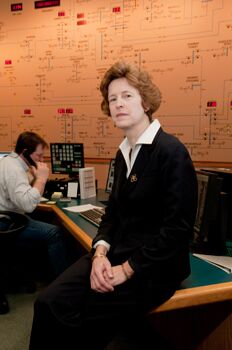Grid lock | An old transmission network takes the sizzle out of renewable energy plans
When Jerry Tudan, president of Peregrine Technologies Inc. in Harpswell, first proposed a biomass boiler in Millinocket five years ago, he went through all the right steps. He pitched the idea to Millinocket officials and won $25,000 in grant money from the Wilderness Society to perform an engineering survey. He lined up a number of logging and wood chip companies to supply the waste wood to fuel the boiler, and he secured an investor, Ontario-based First National Power, to foot the $50 million cost of the boiler. Then he called ISO New England, the regional transmission organization that serves most of Maine, to make sure there would be room on the grid to transmit energy generated by the small 17-megawatt biomass boiler. “When I started, there was plenty of room on the grid. It was the first thing I checked,” he says.
But last June, when it came time to register the project with ISO, Tudan was told the grid was “maxed out,” he says. In those five years, other generators had registered for grid space, including the Stetson Wind Farm, a 38-turbine wind farm with the capacity to generate 57 megawatts of electricity that went online in January. And with other generators already connected, there was no way for Tudan to get his electricity to market. The transmission line just didn’t have the capacity to handle the increase. “It’s like trying to throw a football into a ketchup bottle,” he says. “You just can’t do it, can you?”
Tudan’s experience isn’t unique. Just this month, Aroostook Wind Energy, a subsidiary of Texas-based Horizon Wind Energy, put on hold its plans to develop a wind farm in northern Maine, after a study found “significant issues” that would result from pumping 800 megawatts of wind energy into the grid, according to documents the company filed with the Maine Public Utilities Commission. The company was vague on the technical details, but the PUC documents highlight impediments that would have threatened the grid’s reliability.
Maine, like other states, is facing a difficult challenge: how to incorporate energy generators of the future with a grid that’s stuck in the past. Though Maine has been touted as a potential renewable energy hub, the New England area has also been identified as a site of transmission congestion, according to a 2006 study by the U.S. Department of Energy. The state may be ripe for wind, water and wood energy, but it’s operating on a grid that’s more than four decades old, which some say could put the brakes on more alternative energy projects like Tudan’s and Aroostook Wind Energy’s.
Growing interest in renewable energy has spurred development of expansive wind farms in Texas and solar farms in California. But while many laud efforts to reduce the country’s greenhouse gas emissions, the addition of massive amounts of alternative energy is too much for the nation’s electricity grid to handle. A November 2008 report by the North American Electric Reliability Corp. found that limitations in the nation’s grid are already “inadequate to reliably integrate new renewable resources.” And since more than half the states, Maine included, have adopted renewable portfolio standards that require utilities to get a certain percentage of their energy supplies from renewable sources, the problem is anticipated to worsen.
The reason? Renewable sources like wind and solar power tend to be located in more remote parts of the country, far from population centers, requiring the construction of miles of new transmission lines just to connect the source to the grid. The variable nature of renewable sources poses a problem as well, since electricity isn’t generated unless the wind is blowing or the sun is shining. And in some places, the amount of electricity generated by a wind farm or other renewable source can exceed the capacity of the transmission line, creating congestion that prevents the energy supply from reaching demand.
“If we keep everything as it is today, there is a limit on the percentage of renewable resources we can put on the grid, and we want to get past that,” says Don Von Dollen, program manager for the IntelliGrid project at the Electric Power Research Institute, based in Palo Alto, Calif. But simply building new transmission isn’t enough to solve the reliability issues caused by adding intermittent energy producers like wind and solar. “Unless we come up with some technology that addresses the variability, we can only go so far,” he says.
A grid for the last century
Tudan had been selling small wood-fueled power units to Maine’s dowel manufacturers for a little more than a decade when he decided to pursue the Millinocket biomass boiler. The boiler would have burned about 300,000 tons annually of waste wood — bark, branches and trimmings left behind by logging companies — generating enough power to heat a greenhouse or an aquaculture facility. Tudan and a partner personally funded the costs of feasibility studies and due diligence expenses not covered by the $25,000 grant; Tudan wouldn’t specify an amount, but said it was “substantial.” The sole proprietor and employee of Peregrine Technologies, Tudan works as an energy management consultant and energy wholesale broker. He regularly checked with ISO New England about grid space for his project, never anticipating he’d get shut out completely.
“Maine has got to resolve its transmission issues, or it’s going to hold up everything,” he says, sipping coffee at The Little Dog coffee shop in Brunswick a few miles from his Harpswell home office. “Getting these alternative energy options into the grid is wonderful, but how are we going to move electrons if we don’t have the lines?”
Since it was built in 1971, the 8,000-mile New England bulk transmission grid — the high voltage lines that carry electricity from generation sources to distribution sources — has not undergone a major overhaul, even as electricity consumption has doubled. Since 2001, ISO New England has identified spots in the New England grid prone to congestion and $3 billion so far has been spent to add transmission lines in those areas. ISO has identified another $4-$5 billion in necessary upgrades to boost transmission reliability.
These types of congestion problems are the impetus for Central Maine Power’s Maine Power Reliability Program, a $1.5 billion project proposed last July that would build 313 miles of new transmission line and upgrade 183 miles of existing transmission line, as well as build six new substations, expand nine and upgrade another 20 across the southern and central portions of the state. The project, for which Maine would pay 9 percent of the cost, is the result of an 18-month study of the state’s electricity grid that predicts serious reliability issues by 2017 if upgrades aren’t made, says Sara Burns, president and CEO of CMP. “If we don’t do this, the lights will go out in southern Maine.”
In her Augusta office overlooking a side street, Burns brings out a series of poster-size maps and charts that she uses as she tours the state explaining the company’s upgrade proposal. They’ve been used so much the corners have started to peel and tear. As she points out the places where CMP would beef up transmission lines, she explains that the company will use all of its existing rights-of-way to minimize the impact on land and residents. If the PUC approves the project, construction would start this summer and take about two years.
It will also be an important stepping stone in Maine’s quest to become an alternative energy hub. “[The MPRP] builds the platform for that,” says Burns, adding that all new and modified substations are equipped with fiber-optic cables that allow the utility to remotely monitor electricity transmission, an important first step in managing the variable outputs of renewable sources. So far, 60 out of CMP’s 225 substations have fiber optics. “Someone told me that they see this program as Maine’s Erie Canal,” Burns says. “It will open Maine up to all kinds of opportunities, including investing in renewables. But if we don’t do it, Maine stays closed.”
Article continues after the map
But not everyone agrees that more transmission is the key to solving Maine’s grid problems. Since CMP announced its MPRP eight months ago, GridSolar LLC, a subsidiary of Portland-based Competitive Energy Services, has been developing a counter project company partners say would offer lower rates for customers and turn the state into a leading renewable energy provider. In February, GridSolar filed a petition with the Maine PUC to develop up to 800 megawatts of solar energy by building a number of 25-acre solar panel farms around the southern, central and coastal parts of the state prone to reliability issues, according to Mark Isaacson, one of the partners.
The grid’s reliability problems only come into play on peak days during the hot summer months, which represents about 850 hours a year, says Isaacson. The solar panels would generate about 2 megawatts of power and backup generators would supplement when the sun isn’t shining. Isaacson and his partner, Richard Silkman, say the project would deliver electricity more directly to the demand centers without having to pay for long transmission lines, and could be built in stages based on how much and how fast electricity demand increases. “It seemed to us like [the CMP project] was spending a great deal of money for a problem that’s occurring a small amount of the time,” says Isaacson.
If the PUC approves GridSolar as a transmission generator and distributor, the company plans to start by building the first 100 megawatts, or about 50 solar farm sites, which would cost $450 million.
Transmission: A matter of checks, and balances
On Jan. 22, 38 turbines at the largest wind farm in New England began to turn, their whirling blades only a shade darker than the snowy gray sky. The Stetson Wind farm in Washington County, owned by Massachusetts-based First Wind, is expected to generate enough electricity to power 23,000 homes in the New England grid. With two major wind farms now online, Maine is the leading wind energy producer in New England. And more projects are waiting in the wings. Nearly 3,000 megawatts of new wind power have been proposed in Maine, almost doubling Maine’s current generation capacity.
First Wind has not had any problems connecting its wind farms to the grid, says Kurt Adams, senior vice president of transmission development, due in part to the company’s willingness to build additional transmission to handle the load, like the 38-mile cable constructed to connect Stetson Wind to the grid.
But problems connecting to the grid have stymied Aroostook Wind Energy’s plans for 800 megawatts of wind power in northern Maine. The company has invested millions into acquiring land rights and feasibility studies, according to PUC documents. The project was tied to the Maine Power Connection, a proposed $625 million, 200-mile transmission line from Detroit, Maine to Limestone to connect Aroostook County — one of the few places in the continental United States not hooked up to the U.S. grid — with ISO New England.
But a study performed last fall showed technical problems affecting grid reliability in parts of southern New England if the project went online. Parts of Massachusetts and Connecticut don’t have enough transmission capacity to handle a peak load. An additional 800 megawatts of power coming onto the grid during a peak time could overload the lines, says Brent Boyles, president and CEO of Maine Public Service Co., the utility for northern Maine.
That problem is compounded by the intermittent nature of wind energy, according to Von Dollen, of the Palo Alto power research institute. “I hate to say it, but one of the great things about fossil fuel plants is that you flip a switch and the electricity comes out,” he says. “It’s a steady and reliable source. With wind or solar, it’s a variable source — a good bit of variability that can create reliability problems.”
Researchers have been studying innovative ways to add information technology to the grid to help manage the variable load by creating what’s known as a Smart Grid, but these solutions could be years out [for more on this, see “Building a smarter grid,” this page]. Right now, getting large wind developments in northern Maine on to the grid would mean paying to build additional transmission on top of the Maine Power Connection. But so far, neither Aroostook Wind nor Maine Public Service Co. is willing to take on that cost. “Generally, wholesale power prices are declining, and the prices we would have realized in Aroostook County have gone down,” says Brian Lammers, regional development director for Horizon Wind Energy, Aroostook Wind’s parent company. “Our company is not willing to absorb significant cost of transmission at this time.”
In light of the technical problems and Aroostook Wind’s decision not to fund further studies or additional transmission, the PUC on Feb. 5 found “the underlying rationale for the MPC project has evaporated” and granted a motion to dismiss the case for the Maine Power Connection filed by opponents of the project.
But Aroostook Wind Energy isn’t giving up on Maine yet. “We’re actively developing the site … and we’re looking to other transmission solutions to get power from the area to market,” says Lammers. One alternative is to designate certain areas as wind zones in need of new transmission. The company originally planned to put the first of its wind farms online in 2010, but now has no set timeline, Lammers says.
And Maine Public Service Co. hasn’t resigned itself to staying disconnected from the rest of the state forever. Boyles says Maine Public Service and CMP will continue to explore ways to make the Maine Power Connection work, including applying for cost-sharing through ISO New England, seeking a portion of the $11 billion contained in the federal stimulus package for transmission upgrades or changing the scale of their project. A renewable energy industry could transform northern Maine’s economy, but without building the transmission capacity to send that energy to the grid, the region’s potential could end up blowing away altogether. “It’s like the [movie] ‘Field of Dreams’,” says Boyles. “But if you build the transmission line, will the developer build a generator ... whether it’s a wind farm or something else?”
Mindy Favreau, Mainebiz staff reporter, can be reached at mfavreau@mainebiz.biz.
Read Part 1, "Gale force"
Read Part 2, "Energy projects target Wiscasset"














Comments